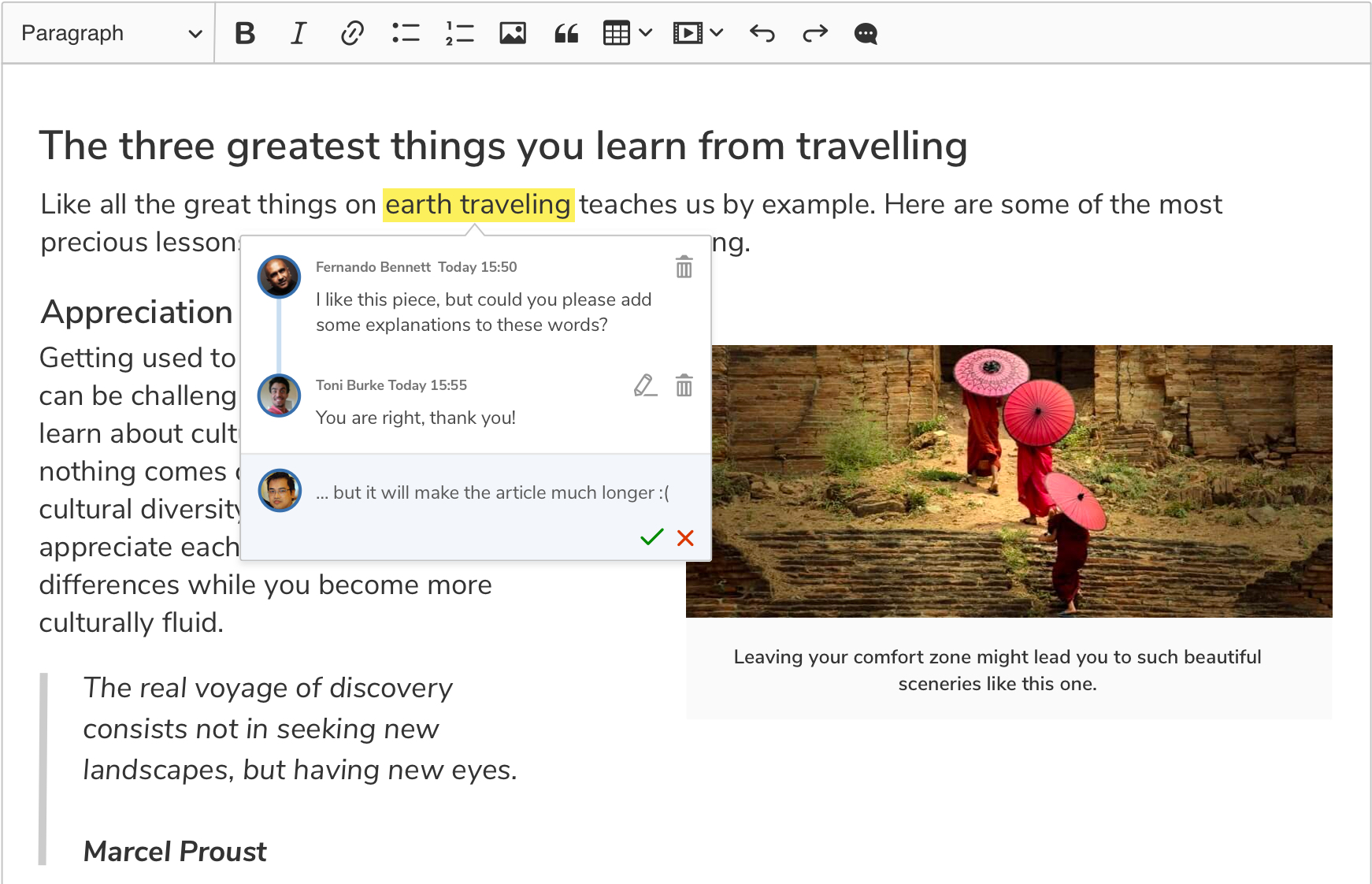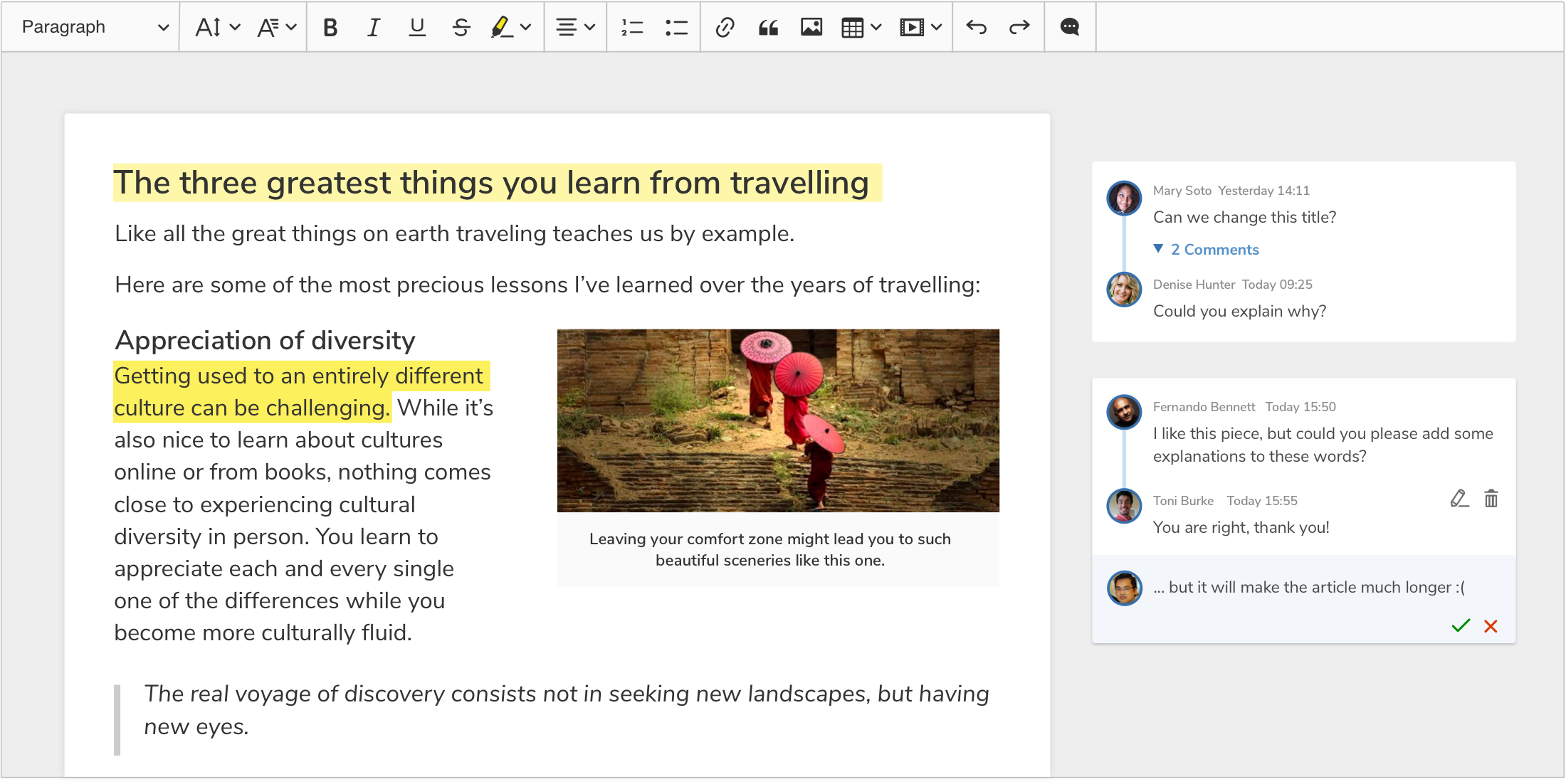 批注显示模式
批注显示模式
有三种内置 UI 用于显示评论线程和建议批注:宽边栏、窄边栏和内联气泡。您也可以在更高级的场景中将它们一起显示,其中各种批注来源(评论、建议)与不同的 UI 相连,甚至可以为批注创建自己的 UI。
# 内联气泡
内联气泡显示模式专为窄屏幕(如移动设备)和使用 WYSIWYG 编辑器编辑内容一小部分的 UI 而设计。

内联显示模式是默认解决方案。当未指定边栏配置时使用它。
即使设置了边栏配置,您也可以通过使用'inline'参数调用switchTo()方法动态切换到内联显示模式
// ...
ClassicEditor
.create( document.querySelector('#editor'), editorConfig )
.then( editor => {
editor.plugins.get( 'AnnotationsUIs' ).switchTo( 'inline' );
// The sidebar container is not removed automatically,
// so it is up to your integration to hide it (or manage in another way).
document.querySelector( '.editor-container__sidebar' ).style.display = 'none';
} );
目前,内联气泡 UI 仅适用于编辑器批注,不能与上下文功能一起使用。
# 宽边栏
宽边栏可以容纳最多的信息量。在此模式下,用户可以看到每个讨论的开头和结尾,以及当前选中标记的整个讨论。只要有足够的空间,它就是推荐的解决方案。

如果您是从评论集成指南中来到这里的,您的编辑器将已经以宽边栏模式显示批注,并且不需要任何额外的配置。以下说明适用于需要在显示模式之间切换或自定义边栏的场景。
要使用宽边栏显示评论和建议批注,首先,准备适当的 HTML 结构
<!DOCTYPE HTML>
<html>
<head>
<meta charset="utf-8" />
<title>CKEditor 5 Sample</title>
</head>
<body>
<div class="main-container">
<div class="editor-container editor-container--classic-editor editor-container--include-annotations" id="editor-container">
<div class="editor-container__editor-wrapper">
<div class="editor-container__editor"><div id="editor"></div></div>
<div class="editor-container__sidebar"><div id="editor-annotations"></div></div>
</div>
</div>
</div>
<script type="module" src="./main.js"></script>
</body>
</html>
然后更新 CSS 样式以在编辑器的右侧显示边栏
.editor-container {
--ckeditor5-preview-sidebar-width: 270px;
}
.editor-container__editor-wrapper {
display: flex;
width: fit-content;
}
.editor-container--classic-editor .editor-container__editor {
min-width: 795px;
max-width: 795px;
}
.editor-container__sidebar {
min-width: var(--ckeditor5-preview-sidebar-width);
max-width: var(--ckeditor5-preview-sidebar-width);
margin-top: 28px;
margin-left: 10px;
margin-right: 10px;
}
然后,初始化富文本编辑器。在配置中,将编辑器设置为使用<div id="editor-annotations">元素作为评论容器。
// ...
const editorConfig = {
// ...
sidebar: {
container: document.querySelector('#editor-annotations')
},
// ...
}
ClassicEditor.create( document.querySelector('#editor'), editorConfig );
在设置了如上例所示的配置后,将使用宽边栏显示模式。如果显示模式已更改,您可以通过调用switchTo()将其更改回
ClassicEditor
.create( document.querySelector('#editor'), editorConfig )
.then( editor => {
editor.plugins.get( 'AnnotationsUIs' ).switchTo( 'wideSidebar' );
} );
您也可以使用setContainer()方法动态设置边栏容器
ClassicEditor
.create( document.querySelector('#editor'), editorConfig )
.then( editor => {
editor.plugins.get( 'Sidebar' ).setContainer( element );
} );
如果边栏容器已设置,则其中所有的项目将被移动到新的容器中。
# 窄边栏
窄边栏是宽边栏和内联气泡之间的折衷方案。它不像宽边栏那样占用大量空间,但包含的信息比内联批注更多。用户会立即看到何时将多个评论线程添加到同一个位置,以及添加了多少评论。

宽边栏和窄边栏的 HTML 结构类似。唯一的区别是您需要为#editor-annotations元素设置不同的min-width CSS 属性
/* ... */
.editor-container__sidebar {
min-width: 65px;
}
/* ... */
然后,初始化编辑器并使用switchTo()方法将 UI 切换到narrowSidebar模式。请注意,您需要手动切换 UI 类型,因为默认情况下将显示宽边栏。
// ...
const editorConfig = {
// ...
sidebar: {
container: document.querySelector('#editor-annotations')
},
// ...
}
ClassicEditor
.create( document.querySelector('#editor'), editorConfig );
.then( editor => {
editor.plugins.get( 'AnnotationsUIs' ).switchTo( 'narrowSidebar' );
} );
# 多个 UI
批注旨在支持同时显示各种批注 UI。这使您能够在不同位置显示不同的批注来源,例如,在宽边栏中显示评论,同时在内联气泡中显示建议。
要同时激活多个 UI,应将过滤函数传递给activate()方法。该函数指定哪个批注由给定的 UI 控制。请注意,一个批注不能同时由多个AnnotationsUI管理。如果批注未被任何批注 UI 接受,则该批注将不会显示。
要使用批注 UI 的组合显示评论和建议批注,首先准备适当的 HTML 结构(出于演示目的,使用宽边栏)
<html>
<head>
<style type="text/css">
#container {
display: flex;
position: relative;
}
#container .ck.ck-editor {
width: 100%;
max-width: 700px;
}
#sidebar {
min-width: 300px;
padding: 0 10px;
}
</style>
</head>
<body>
<div id="container">
<div id="editor"></div>
<div id="sidebar"></div>
</div>
</body>
</html>
然后,使用包含注释和修订跟踪功能的预设来初始化富文本编辑器。您可以从修订跟踪集成指南中获取必要的代码。然后调整代码以使用两个注释 UI,如下所示
// ...
ClassicEditor
.create( document.querySelector('#editor'), editorConfig )
.then( editor => {
const annotationsUIs = editor.plugins.get( 'AnnotationsUIs' );
// Deactivate all UIs first as the `activate()` method might not deactivate all UIs.
annotationsUIs.deactivateAll();
annotationsUIs.activate( 'wideSidebar', annotation => annotation.type === 'comment' );
annotationsUIs.activate( 'inline', annotation => annotation.type !== 'comment' );
} );
# 所有显示模式的实际操作
以下代码片段允许在所有可用的显示模式之间切换。
作为对本指南的补充,我们提供了一个可供下载的示例。您可以将示例用作示例或作为您自己的集成的起点。请注意,此示例不仅涵盖注释,还涵盖修订跟踪建议。
以下代码片段需要包含注释和修订跟踪插件的设置。查看修订跟踪集成指南以获取代码。
在从 Builder 获取的index.html文件中,添加以下标记
<body>
<!-- ... -->
<div class="buttons">
<button id="inline">Inline</button>
<button id="narrow">Narrow sidebar</button>
<button id="wide">Wide sidebar</button>
<button id="wide-inline">Wide sidebar + inline</button>
</div>
<!-- ... -->
</body>
然后,在style.css文件中,添加以下样式
.editor-container__sidebar {
transition: min-width .4s ease-out-in;
}
.editor-container__sidebar.narrow {
min-width: 65px;
}
.editor-container__sidebar.hidden {
display: none;
}
最后,在main.js文件中添加以下代码
ClassicEditor
.create( document.querySelector('#editor'), editorConfig )
.then( editor => {
const annotationsUIs = editor.plugins.get( 'AnnotationsUIs' );
const annotationsContainer = document.querySelector( '.editor-container__sidebar' );
const inlineButton = document.querySelector( '#inline' );
const narrowButton = document.querySelector( '#narrow' );
const wideButton = document.querySelector( '#wide' );
const wideAndInlineButton = document.querySelector( '#wide-inline' );
function markActiveButton( button ) {
[ inlineButton, narrowButton, wideButton, wideAndInlineButton ]
.forEach( el => el.classList.toggle( 'active', el === button ) );
}
function switchToInline() {
markActiveButton( inlineButton );
annotationsContainer.classList.remove( 'narrow' );
annotationsContainer.classList.add( 'hidden' );
annotationsUIs.switchTo( 'inline' );
}
function switchToNarrowSidebar() {
markActiveButton( narrowButton );
annotationsContainer.classList.remove( 'hidden' );
annotationsContainer.classList.add( 'narrow' );
annotationsUIs.switchTo( 'narrowSidebar' );
}
function switchToWideSidebar() {
markActiveButton( wideButton );
annotationsContainer.classList.remove( 'narrow', 'hidden' );
annotationsUIs.switchTo( 'wideSidebar' );
}
function switchToWideSidebarAndInline() {
markActiveButton( wideAndInlineButton );
annotationsContainer.classList.remove( 'narrow', 'hidden' );
annotationsUIs.deactivateAll();
annotationsUIs.activate( 'wideSidebar', annotation => annotation.type === 'comment' );
annotationsUIs.activate( 'inline', annotation => annotation.type !== 'comment' );
}
editor.ui.view.listenTo( inlineButton, 'click', () => switchToInline() );
editor.ui.view.listenTo( narrowButton, 'click', () => switchToNarrowSidebar() );
editor.ui.view.listenTo( wideButton, 'click', () => switchToWideSidebar() );
editor.ui.view.listenTo( wideAndInlineButton, 'click', () => switchToWideSidebarAndInline() );
// Set wide sidebar as default.
switchToWideSidebar();
} )
.catch( error => console.error( error ) );
# 演示
以下示例展示了上面的代码片段
# 自定义 UI
除了内置的注释 UI 之外,还可以创建自定义 UI,以更适合您的应用程序的方式显示注释。
请注意,注释 UI 应该实现AnnotationsUI接口。
注释 UI 的框架如下所示。为了使其正常工作,它必须包含在编辑器插件列表中并被激活。这些是您需要对项目main.js文件进行的更改
// ...
import { ContextPlugin } from 'ckeditor5';
// ...
class CustomAnnotationsUI extends ContextPlugin {
static get pluginName() {
return 'CustomAnnotationsUI';
}
constructor( ...args ) {
super( ...args );
// The `activeAnnotation` property should be defined as an observable property.
this.set( 'activeAnnotation', null );
}
// The `attach()` method should create everything needed for the UI and
// attach all listeners. This method is called when the UI is activated.
//
// The observable collection of annotations is passed as the first argument,
// and the annotations UI is responsible for reacting to its changes.
attach( annotations ) {
// Do something when an annotation is added.
this.listenTo( annotations, 'add', ( evt, annotation ) => { /* ... */ } );
// Do something when an annotation is removed.
this.listenTo( annotations, 'remove', ( evt, annotation ) => { /* ... */ } );
}
// The `detach()` method should destroy the UI and remove all listeners.
// This method is called when the UI is deactivated.
detach() {
this.stopListening();
}
// The `setActiveAnnotation()` method should set or unset the active annotation.
setActiveAnnotation( annotation ) {
if ( this.activeAnnotation ) {
this.activeAnnotation.isActive = false;
// You can do something in your UI with the annotation that is no longer active.
// ...
}
if ( annotation ) {
this.activeAnnotation = annotation;
this.activeAnnotation.isActive = true;
// You can do something in your UI to highlight the active annotation.
// ...
}
}
}
// ...
const editorConfig = {
// ...
plugins: [ /* ... */, CustomAnnotationsUI ],
// ...
};
ClassicEditor
.create( document.querySelector('#editor'), editorConfig )
.then( editor => {
const annotationsUIs = editor.plugins.get( 'AnnotationsUIs' );
const customAnnotationsPlugin = editor.plugins.get( 'CustomAnnotationsUI' );
annotationsUIs.register( 'customUI', customAnnotationsPlugin );
annotationsUIs.switchTo( 'customUI' );
} );
我们每天都在努力使我们的文档保持完整。您是否发现了过时的信息?是否缺少内容?请通过我们的问题跟踪器报告。
随着 42.0.0 版本的发布,我们重新编写了大部分文档以反映新的导入路径和功能。感谢您的反馈,帮助我们确保其准确性和完整性。

